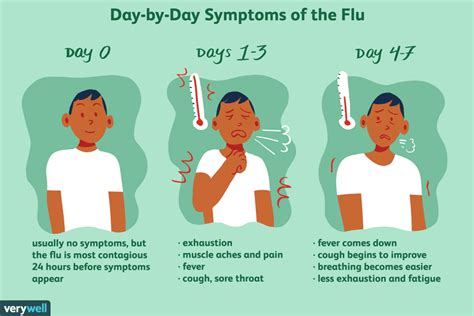The Flu Day By Day

Understanding the progression of the flu is crucial for managing symptoms, preventing complications, and deciding when to seek medical help. The flu, or influenza, is a respiratory illness caused by flu viruses. It can cause mild to severe illness and can sometimes lead to death. The progression of the flu can vary significantly from person to person, but it generally follows a predictable course. Here, we’ll break down the flu day by day to help you understand what to expect and when to take action.
Day 1-2: Incubation Period
The flu’s incubation period is the time between exposure to the flu virus and the onset of symptoms. This period is usually about 1 to 4 days, with an average of 2 days. During this time, you won’t have any symptoms but can still infect others. It’s essential to practice good hygiene, such as frequent hand washing and avoiding close contact with others, especially during this period.
Day 3-4: Onset of Symptoms
The onset of flu symptoms can be sudden. Common symptoms include: - Fever (usually high) - Chills - Cough - Sore throat - Runny or stuffy nose - Headache - Fatigue (feeling extremely tired) - Muscle or body aches - Diarrhea and vomiting (more common in children than adults)
At this stage, rest and hydration are key. Drinking plenty of fluids, such as water, clear broth, or electrolyte-rich beverages like sports drinks, can help replace lost fluids and electrolytes. Over-the-counter medications like acetaminophen (Tylenol) or ibuprofen (Advil, Motrin) can help reduce fever and relieve headache, muscle aches, and sore throat. However, always follow the recommended dosage instructions, and consult your doctor before giving any medication to children.
Day 5-6: Peak of Illness
By the fifth or sixth day, the flu symptoms often peak. This is when you’re likely to feel the worst. Fever usually subsides within 3 to 4 days, but you may still feel weak and fatigued. Cough and fatigue can last for up to 2 weeks or more. It’s crucial to continue resting and avoiding strenuous activities to help your body recover. Also, monitor your symptoms closely for any signs of complications, such as difficulty breathing, chest pain, or severe headache.
Day 7 and Beyond: Recovery
Most people start feeling better after about a week, but it may take longer for fatigue to completely resolve. During the recovery phase, it’s essential to: - Gradually return to your normal activities to avoid relapse. - Continue practicing good hygiene to prevent the spread of the virus to others. - Watch for signs of secondary bacterial infections, such as pneumonia, which can be a serious complication of the flu, especially in high-risk groups like the elderly, young children, and people with certain chronic health conditions.
Complications and When to Seek Medical Help
While most people can recover from the flu with rest and hydration, certain groups are at higher risk for complications, including: - Children under 5 years old - Adults 65 years and older - Pregnant women - People with certain chronic health conditions (like heart disease, lung disease, or diabetes) - People with weakened immune systems
If you experience any of the following, seek medical attention: - Difficulty breathing or shortness of breath - Chest pain or pressure - Sudden dizziness or confusion - Severe or persistent vomiting - Flu-like symptoms that improve but then return with fever and worse cough - Fever above 103°F (39.4°C)
Prevention
Preventing the flu is always better than treating it. The most effective way to prevent the flu is by getting a flu vaccine each year. The vaccine is updated annually to protect against the most common flu viruses for that season. Other preventive measures include: - Practicing good hygiene (frequent hand washing, avoiding close contact with sick individuals) - Avoiding touching your eyes, nose, and mouth - Cleaning and disinfecting surfaces and objects that may be contaminated with flu virus - Avoiding sharing personal items like utensils, drinks, or towels
Understanding the progression of the flu and taking proactive steps can significantly reduce your risk of getting the flu and its complications. If you’re in a high-risk group or have concerns about your symptoms, always consult with your healthcare provider for personalized advice.
What are the most common symptoms of the flu?
+The most common symptoms of the flu include fever, chills, cough, sore throat, runny or stuffy nose, headache, fatigue, muscle or body aches, and sometimes diarrhea and vomiting. These symptoms can range from mild to severe and can sometimes lead to serious complications.
How can I prevent the flu?
+The best way to prevent the flu is by getting a flu vaccine each year. Additionally, practicing good hygiene (like frequent hand washing), avoiding close contact with sick individuals, avoiding touching your eyes, nose, and mouth, and regularly cleaning and disinfecting surfaces and objects can help prevent the spread of the flu virus.
Who is at higher risk for flu complications?
+Certain groups are at higher risk for flu complications, including children under 5 years old, adults 65 years and older, pregnant women, people with certain chronic health conditions, and people with weakened immune systems. These individuals should take extra precautions to prevent the flu and seek medical attention promptly if they develop flu symptoms.
